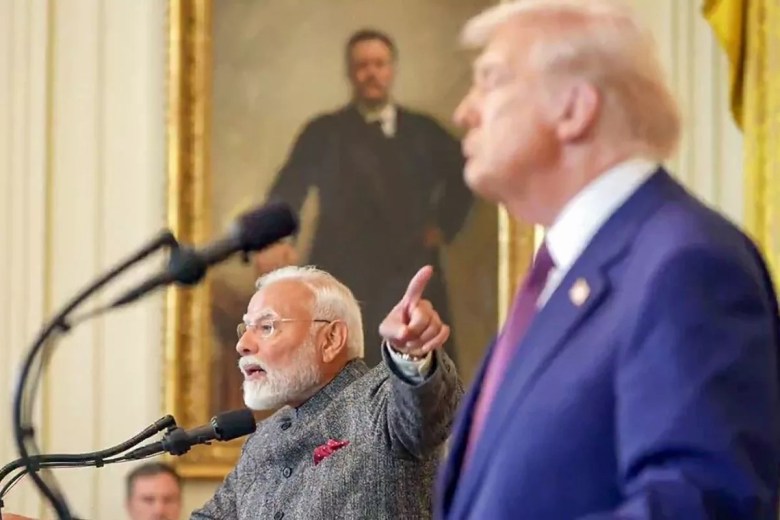Politics
Trump Tightens Grip on India with New Visa Fees and Sanctions

On September 19, 2025, U.S. President Donald Trump enacted a series of measures that have shocked Indian policymakers, following a seemingly friendly birthday call to Indian Prime Minister Narendra Modi just two days earlier. Trump’s executive order includes a substantial annual fee of $100,000 for H-1B visas, a move that primarily affects Indian nationals who hold approximately 73% of these visas. The timing of these actions raises questions about the nature of U.S.-India relations and the strategic calculus behind them.
The imposition of tariffs and fees comes on the heels of a 50% tariff on Indian goods announced on August 27, 2025. This escalation has left many in India reeling, particularly as the U.S. also revoked an exemption related to India’s involvement in the Chabahar port project in Iran. This project is crucial for India’s connectivity to Afghanistan and Central Asia, allowing it to circumvent Pakistan and counter Chinese influence in the region. The U.S. waiver, previously granted under Trump’s first term, was intended to protect this initiative from sanctions, but its sudden withdrawal is set to jeopardize $500 million in Indian investments.
Trump’s actions, which also included designating India as a major drug transit country, suggest a calculated strategy to pressure India into compliance on various issues, particularly in ongoing trade negotiations. The H-1B visa fee increase threatens the Indian information technology sector, which relies heavily on these visas for its workforce. Major companies such as Tata Consultancy Services, Infosys, and Wipro face potential billions in additional costs, which could impact their hiring capabilities and disrupt the flow of $125 billion in annual remittances to Indian states like Andhra Pradesh and Telangana.
The implications of these measures extend beyond economics. They also threaten Modi’s standing among the Indian diaspora in the United States, who may perceive these sanctions as a failure of the Indian government to safeguard their interests. The political ramifications could undermine Modi’s image as a global leader, especially as he seeks to position India as a responsible power on the international stage.
India’s predicament arises from an overreliance on American goodwill, exemplified by External Affairs Minister S. Jaishankar‘s vision for closer ties with the U.S. This strategy has been evident since India signed four foundational defense agreements with the U.S. and positioned itself as a counterbalance to China. However, the anticipated economic benefits have not materialized. Free trade negotiations have stalled, and India’s withdrawal from the Regional Comprehensive Economic Partnership in 2020 showcased a broader hesitancy to engage with global trade frameworks, largely due to fears of increased Chinese dominance.
Trump’s recent actions appear to be aimed at maximizing leverage in trade talks, particularly regarding Indian purchases of Russian oil. The U.S. has been pressuring India to reduce its reliance on discounted Russian energy, which has been a stabilizing factor amid global price fluctuations. The implications of these sanctions are significant, as they could extend to various sectors, including pharmaceuticals and textiles, which are vital to India’s economy.
The broader geopolitical landscape complicates India’s position. Trump’s actions suggest a desire to tighten the U.S.-India relationship while simultaneously keeping India in check. This dynamic has exposed the vulnerabilities in India’s foreign policy, which appears overly dependent on U.S. favor. As Modi’s government navigates this challenging terrain, it is clear that a recalibration of foreign policy is necessary.
India needs to diversify its international partnerships, fostering deeper ties with Europe, ASEAN, and African nations, while balancing its relations with both China and Russia. The recent measures from Trump serve as a stark reminder that reliance on a single superpower can lead to diplomatic isolation and economic vulnerability.
As the situation unfolds, the question remains: what further actions might Trump take if India does not bend to U.S. demands? Tariffs could expand, and sanctions may target Indian military procurements, potentially crippling India’s defense capabilities. The urgency for India to adopt a multidimensional and independent foreign policy has never been more apparent, as the stakes continue to rise in this complex geopolitical landscape.
-

 Business5 months ago
Business5 months agoKenvue Dismisses CEO Thibaut Mongon as Strategic Review Advances
-

 Lifestyle4 months ago
Lifestyle4 months agoHumanism Camp Engages 250 Youths in Summer Fest 2025
-

 Sports4 months ago
Sports4 months agoDe Minaur Triumphs at Washington Open After Thrilling Comeback
-

 Sports5 months ago
Sports5 months agoTupou and Daugunu Join First Nations Squad for Lions Clash
-

 Top Stories5 months ago
Top Stories5 months agoColombian Senator Miguel Uribe Shows Signs of Recovery After Attack
-

 World5 months ago
World5 months agoASEAN Gears Up for Historic Joint Meeting of Foreign and Economic Ministers
-

 Health4 months ago
Health4 months agoNew Study Challenges Assumptions About Aging and Inflammation
-

 Business5 months ago
Business5 months agoOil Prices Surge Following New EU Sanctions on Russia
-

 Entertainment4 months ago
Entertainment4 months agoDetaşe-Sabah Violin Ensemble Captivates at Gabala Music Festival
-

 Entertainment4 months ago
Entertainment4 months agoBaku Metro Extends Hours for Justin Timberlake Concert
-

 Top Stories5 months ago
Top Stories5 months agoRethinking Singapore’s F&B Regulations Amid Business Closures
-

 Business5 months ago
Business5 months agoU.S. House Approves Stablecoin Bill, Sends to Trump for Signature









